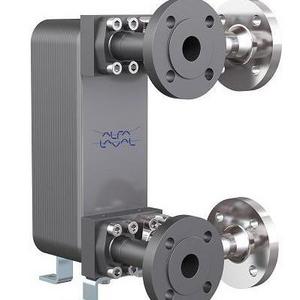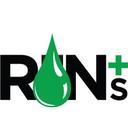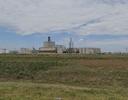Alfa Laval launches new tantalum range of heat exchangers

Photo: Alfa Laval
March 24, 2014
BY Alfa Laval
Alfa Laval is launching a new range of tantalum heat exchangers that offer the exceptionally high corrosion resistance of a solid-tantalum heat exchanger, but at a much lower investment cost. The combined benefits of lower capital cost, long lifetime and minimal maintenance requirements result in significantly lower total cost of ownership compared to heat exchangers made of high-grade alloys, graphite, silicon carbide or glass.
Tantalum is one of the most corrosion-resistant metals, but it’s also very costly, making solid-tantalum heat exchangers extremely expensive.
The heat exchangers in Alfa Laval’s new tantalum range are stainless steel heat exchangers that have undergone a unique treatment where a thin layer of tantalum is metallurgically bonded to all surfaces exposed to corrosive media. The result is maximum corrosion resistance and mechanical stability at a low investment cost, making the technology affordable to a wide range of applications.
Advertisement
The new tantalum range has been specifically developed for use with hot, highly corrosive liquids. The tantalum surface allows Alfa Laval’s new heat exchangers to be used with most corrosive media at temperatures up to 437 degrees Fahrenheit. Unlike many high-grade alloys, they can be used with mixed media and at variable concentrations.
The high chemical resistance and robust design minimizes service needs. The only required maintenance is a cleaning-in-place procedure if the heat exchanger is operating in a fouling duty. The highly turbulent flow helps reduce fouling and makes cleaning-in-place procedures more effective.
The steel core gives the new tantalum heat exchangers high mechanical stability. The robust design gives them much greater resistance to thermal shock than glass, silicon carbide and graphite heat exchangers.
Advertisement
The new heat exchangers are based on plate technology. Thanks to a highly turbulent flow, they have a significantly higher thermal efficiency than a shell-and-tube heat exchanger.
When comparing the efficiency of a shell-and-tube made of nonmetals—such as graphite, glass or silicon carbide—and an Alfa Laval tantalum heat exchanger, the different heat conductivity and required thicknesses of the materials must be considered. By combining superior flow characteristics with the improved heat transfer properties, the new tantalum heat exchangers provide up to 100 times higher thermal efficiency than nonmetal shell-and-tube units.
This results in a much smaller footprint than designs based on graphite, glass or silicon carbide, thereby minimizing installation costs and allowing plant owners to expand capacity on existing floor space.
Related Stories
Biodiesel capacity in the U.S. and Canada dipped slightly stable in 2024, with several renewable diesel producers reporting headwinds and lower margins alongside a drove of SAF projects in various stages of development.
The IEA’s Task 39 group has new research regarding the development and status of the sustainable aviation fuel industry.
The U.S. EPA on Nov. 16 released updated RIN data, reporting that nearly 2.11 billion RINs were generated under the RFS in October, up from 1.81 billion generated during the same month of last year.
Conestoga to host SAFFiRE cellulosic ethanol pilot plant
Conestoga Energy and SAFFiRE Renewables LLC announced on Nov. 16 their agreement for Conestoga to host SAFFiRE’s cellulosic ethanol pilot plant at Conestoga’s Arkalon Energy ethanol facility in Liberal, Kansas.
Officials at Calumet Specialty Products Partners L.P. discussed the company’s proposed plans to boost sustainable aviation fuel (SAF) production at its Montana Renewables biorefinery during third quarter earnings call, held Nov. 9.
Upcoming Events










